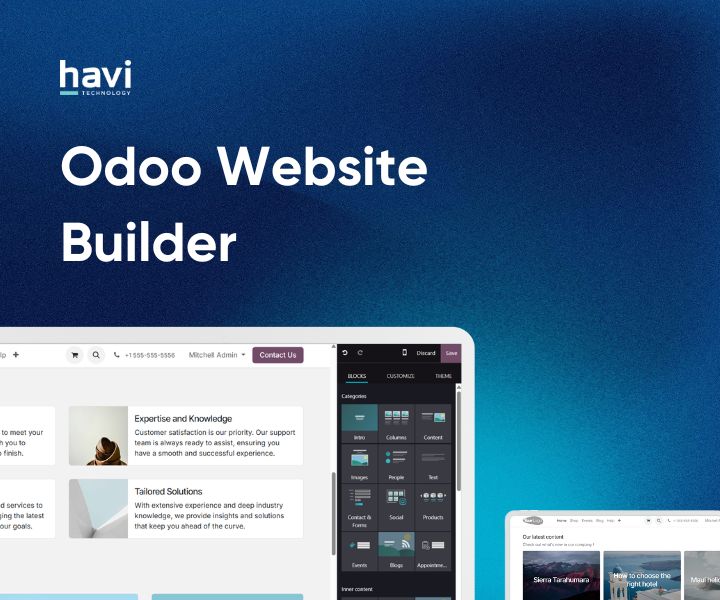TABLE OF CONTENTS
- 1. Website and Customer Experience
- 1.1. Website & eCommerce: Guided Onboarding, New Templates, Google Merchant Sync
- 1.2 Live Chat and Discuss: Expertise Routing, Chat Insights, Status Controls
- 2. Sales, CRM and Subscriptions
- 2.1 Sales: Editable Optional Products, Catalogue Sections, Portal Top-Up
- 2.2. CRM and Marketing: AI Probability, Lead Sources, Kanban Linking
- 2.3. Subscriptions: Prorated Billing, One-Time Sales, Portal Edits
- 3. Inventory, Purchase and Barcode
- 3.1. Inventory and Purchase: Packages within Packages, Forecasted Reports, Suggested Quantity to Replenish
- 3.2. Barcode: Operation Descriptions, Product Source Location, Lot and Serial Number Properties
- 4. Manufacturing, Shop Floor & Planning
- 4.1. MRP: Gantt View, Editable Deadlines, Labour-Based Valuation
- 4.2. Shop Floor & Planning: Barcode Workflows, Shift Scheduling, Routing Edits
- 5. Project, Timesheets and Services
- 5.1. Project and Timesheet: Smart Assign, Mobile Grid View, Priority Alerts
- 5.2. Field Service and Appointments: Calendar View, Technician Tracking, Mass Planning
- 6. HR, Payroll and Expenses
- 6.1. Payroll: Redesigned Engine, Payslip Correction, Unified Master Report
- 6.2. Time Off and Expenses: Odoo Master Cards, Multi-Expense Submission, Complex Duration
- 7. Accounting, Compliance and ESG
- 7.1. Accounting: Peppol Invoicing, Bank Sync, BAS Reports
- 7.2. ESG App: Scope 1–3 Emissions, CSRD Reporting, Auto Category Mapping
- 8. AI, Documents and Sign
- 8.1. AI App: Prompt Commands, Auto Field Completion, Voice and Web Search
- 8.2. Sign and Documents: Bulk Signing, Chatter Integration, Access Controls
- Odoo 19: What’s Coming For Australia?
- 1. Fully compliant Payroll AU with STP Phase 2 and SuperStream
- 2. ABA file payments, Direct Debit for wages/super
- 3. Multi-stream YTD import, backpay, and validations
- 4. 2025–26 tax rules, STSL changes, ATO security
- 5. Peppol invoicing, GST toggle, fringe benefits, BAS automation
- 6. Tyro integration
- 7. Roadmap: SBR BAS lodging, Open Banking, PEL Access, Fiduciary Program
- Odoo 19’s FAQs For Australian Teams
- 1. How should Australian businesses prepare?
- 2. How is Odoo 19 different from Odoo 18 in Australia?
- 3. How can AI in Odoo 19 be tailored for real business outcomes?
- 4. How can I try Odoo 19 or upgrade from my current version?





Odoo Timesheets is Odoo’s native time-tracking application, designed to connect time entries with billing, HR, and project workflows in real time. Unlike standalone trackers, it enables Australian teams to manage timesheets in full compliance with Fair Work audit requirements, GST invoicing rules, and award-based payroll structures.
With native support for Employment Hero and custom integration options for Xero, Odoo connects timesheets with Projects, Sales, and Invoicing — delivering clear resource costing and wage transparency across Australian operations. This guide explores key features, proven adoption tips for Aussie teams, quick setup instructions, and how to turn time tracking into a strategic business enabler.
What are the Key Features of Odoo Timesheets?
Odoo Timesheets provides a fully integrated time tracking suite, enabling Australian businesses to log, validate, analyse, and invoice work hours. See the following video for an overview of Odoo Timesheets:
Below is a breakdown of its core capabilities by functional group:
1. Time Tracking
Odoo lets users track time in real time or enter it manually. The following image shows the Odoo Timesheets dashboard in grid view:
This flexible approach ensures coverage for both active and passive workflows — from consultants billing clients to technicians logging hours after their shift.
2. Task and Project Management
Each time, the entry links directly to a project task. Instead of copy-pasting, users simply select the task from a dropdown, reducing human error and saving time. See the action details in the screenshot below:
This structure supports better project costing and effort visibility, key for organisations that bill by the hour or want to control resource margins in professional services or field-based industries.
3. Mobile and Remote Access
The mobile app brings full timesheet functionality to remote and field teams. The following screenshot shows how a user can manually log time, choose projects/tasks in Odoo Timesheets:
Real-time mobile tracking supports accountability and payroll accuracy while improving operational coverage in businesses with decentralised operations.
4. Employee & Team Management
Managers get full control over who logs what and when. They can choose specific timesheets to validate, as described in the following image:
These features support standardisation across teams while helping ensure the integrity of data that feeds into billing, payroll, and compliance processes.
5. Views for All Roles
Odoo offers five ways to view timesheets for every role. The Timesheets Kanban view is shown in the image below:
This multi-view structure ensures flexibility and relevance — from high-level reporting to day-to-day time entry review — with access governed by user roles.
6. Reporting & Analysis
Built-in reports help teams analyse effort and spot gaps. This screenshot shows non-billable time and time spent filters in the Odoo Timesheets report:
For decision-makers, these reports help clarify whether project delays are time-related and whether staff utilisation aligns with budget expectations. Reporting insights are essential for professional services firms and operational teams managing shift-based performance.
7. Integration with Odoo-Native Apps
Timesheets sync with Sales, Projects, HR, and Invoicing in Odoo. See the converted tracked hours in a sales order in this image:
These integrations eliminate data duplication, support audit trails, and ensure billing is aligned with actual work delivered.
8. Billing and Integration Capabilities for Australia
For Australian businesses, Odoo connects with key local platforms to stay ATO-compliant.
These capabilities ensure that local operations remain compliant, auditable, and aligned with business logic, reducing both risk and manual effort.
Odoo Timesheet’s features only deliver value if used consistently. In the next section, we explore how to drive adoption across teams and build reliable habits that support your operational and compliance goals.
How Can Australian Teams Improve Timesheet Adoption and Accuracy with Odoo?
Adoption and accuracy improve when timesheet workflows are simple, consistent, and aligned with payroll, billing, and compliance. The following strategies focus on enabling reliable, compliant timesheet behaviour using Odoo's native features, contextualised specifically for Australian teams operating under local awards, casual contracts, and hybrid environments.
1. Make It Easy: Use the Mobile App and One-Click Timer
Fast, accessible time entry is the foundation of consistent logging. In Odoo, users can start and stop the timer directly from their mobile app or within a task on the web interface. The mobile experience replicates the same dropdown selection of project and task, essential for field workers, consultants, or hybrid staff logging time across job sites, client meetings, or remote workdays.
Odoo feature in focus:
Practical AU example:
A landscaping services company operating in regional Victoria enables its on-site crews to log time directly from mobile devices after each job. Office staff use shortcuts on the desktop to log in project admins.
Impact:
Removes barriers to real-time logging, reducing the risk of end-of-week estimations that compromise payroll and billing accuracy, particularly for jobs billed to clients or tracked under different pay scales.
2. Use Email Reminders and Lock Deadlines
Odoo automates reminders and sets clear-cut-off rules to protect data accuracy. In addition, the system supports lock dates that prevent users from editing past periods once validated, which is essential for preserving data accuracy in compliance workflows.
Odoo feature in focus:
Practical AU example:
A tech consultancy in Brisbane sets a fortnightly reminder aligned with its payroll cycle. All timesheets are locked 48 hours before processing to ensure clean data flows into Employment Hero for award-based pay calculations.
Impact:
Drives timely submissions, protects data integrity, and aligns with ATO and Fair Work requirements for timekeeping and payroll traceability.
3. Show the 'Why': Link Timesheets to Payroll or Bonuses
When employees see the direct link between time entries and outcomes, accuracy increases. In Odoo, validated timesheets feed into invoicing, billing targets, and even payroll through integrations. This makes time tracking more than an admin task — it becomes a transparent trigger for accurate pay, leave accruals, and performance reviews.
Odoo feature in focus:
Practical AU example:
An engineering firm in Sydney introduces monthly timesheet dashboards where consultants see how their billable hours compare to team targets. Bonuses are calculated based on validated hours billed to clients.
Impact:
Establishes time entry as a revenue lever, not just a compliance tool. Reinforces accountability and improves billing reliability across the project lifecycle.
4. Train Managers to Monitor & Validate Weekly
Regular validation from team leads keeps records timely and trustworthy. In Odoo, team leads can supervise entries by project or user, use filters to spot inconsistencies, and validate time in bulk. Weekly validations create a rhythm that aligns with Australian operational cycles — from weekly payroll to contractor reviews.
Odoo feature in focus:
Practical AU example:
A construction firm with sites across Queensland trains site supervisors to validate or approve time entries every Friday. They review logged hours against planned work using the Grid view, then validate all records in one click.
Impact:
Establishes local responsibility, minimises backlog, and ensures validated data is ready for payroll export to tools like KeyPay or Xero.
5. Use Dashboards or Gamification to Encourage Engagement (Optional)
Dashboards and leaderboards reinforce daily timesheet habits. Odoo offers a billing leaderboard that tracks employees’ billable hours and displays motivational tips.
Odoo feature in focus:
Practical AU example:
A digital agency in Melbourne uses the leaderboard to celebrate top contributors at weekly standups. Motivational quotes are rotated daily to drive friendly competition.
Impact:
How to Set Up Odoo Timesheets?
Step 1: Access the Timesheets App
Launch the Timesheets module from the dashboard. Use the navigation bar to switch between weekly and monthly views. Each day displays task-based time already logged or pending input.
Step 2: Log Your Time
Start the timer or enter hours manually via:
Entries can also be logged from task views. The 15-minute default minimum duration can be adjusted to match Australian Modern Award rounding rules.
Step 3: Monitor Progress
Use colour-coded entries to track:
Daily and weekly totals appear at the bottom of the grid, helping managers and staff stay on track.
Step 4: Validate Timesheets as a Manager
Managers access the “To Validate” tab to:
Validation rights are managed under the Approver field in each employee’s profile.
Step 5: Use List View for Bulk Actions
List View enables team leads or payroll admins to validate or delete multiple entries by selecting relevant lines and applying bulk actions via the dropdown menu.
Step 6: Configure Settings for Rounding, Reminders & More (Optional)
Customise your Timesheets setup via Configuration → Settings:
Managers can also assign billable hour targets. For full setup instructions, refer to Odoo’s official documentation.
What to Know about Odoo Timesheets for Australia?
1. Which Odoo modules work best with Timesheets for service-based businesses?
Odoo Timesheets works best with Projects, Sales, Invoicing, and HR — enabling seamless task tracking, billing, planning, and payroll for services and construction. If you're comparing modules for operational needs, refer to our Odoo features & localisation breakdown.
2. How does Odoo Timesheets compare to third-party time tracking tools in Australia?
Odoo provides deeper integration with finance and ERP workflows. While third-party tools offer simpler mobile UIs, Odoo ensures stronger traceability, billing accuracy, and compliance from a single system.
3. What is the difference between validated and non-validated timesheet entries?
Validated entries are final and feed billing/payroll. Unvalidated ones remain editable and excluded from reports, increasing compliance risk.
4. Can I track time for multiple projects at once in Odoo?
Yes. Switch between tasks via dropdowns or shortcuts. Use grid or pivot views to analyse time by project for full visibility. We walk through features and real use cases in our Odoo project guide for Australia.
Odoo Timesheets, integrated with payroll and invoicing, gives Australian teams clarity and control by turning time tracking into a revenue-aligned, audit-ready process. Book a tailored demo with Havi to see how we localise Odoo Timesheets for real-world use across Australia.
References: